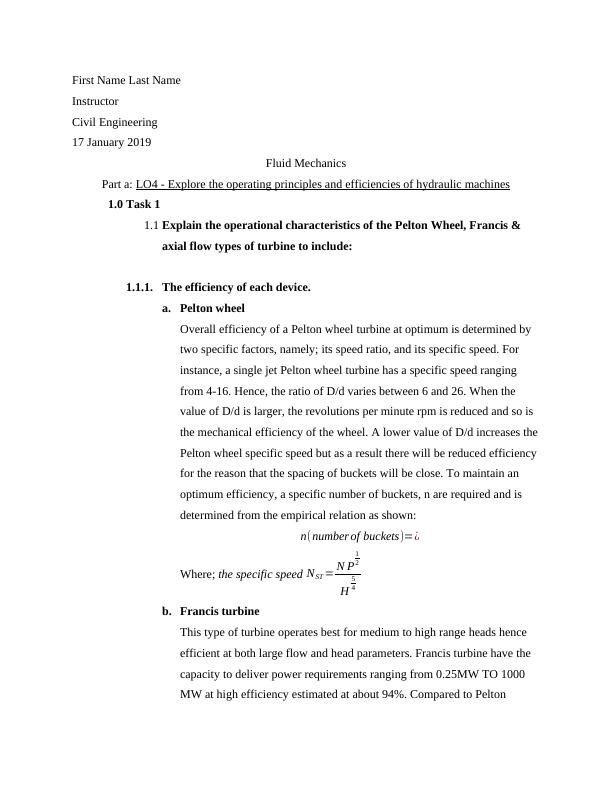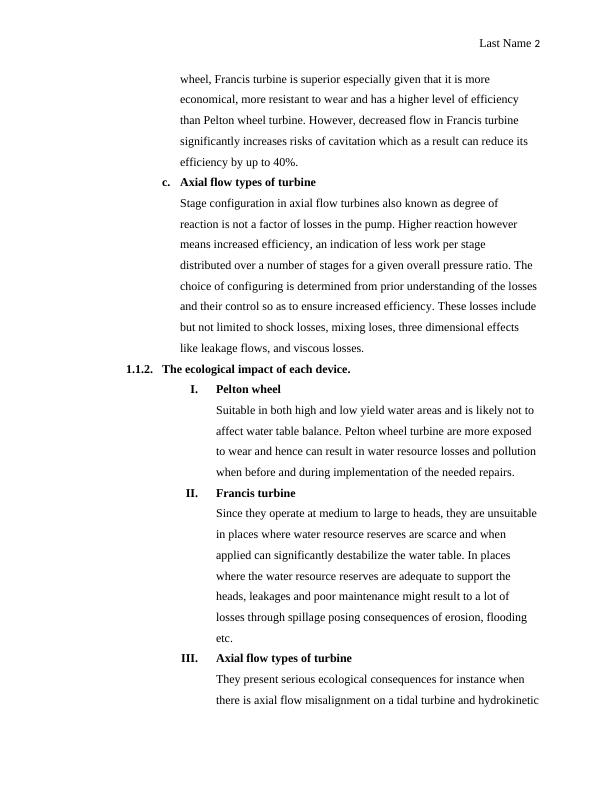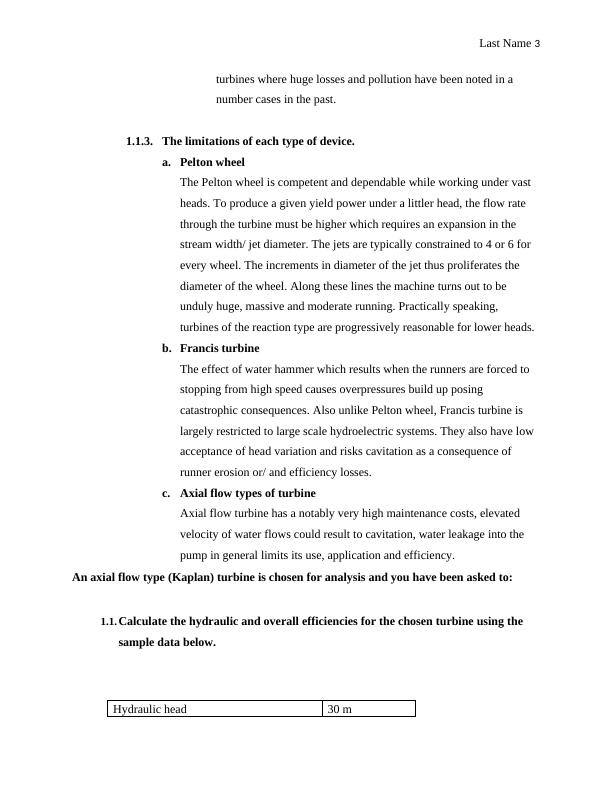Operating Principles and Efficiencies of Hydraulic Machines
Added on 2023-04-22
8 Pages1720 Words66 Views
First Name Last Name
Instructor
Civil Engineering
17 January 2019
Fluid Mechanics
Part a: LO4 - Explore the operating principles and efficiencies of hydraulic machines
1.0 Task 1
1.1 Explain the operational characteristics of the Pelton Wheel, Francis &
axial flow types of turbine to include:
1.1.1. The efficiency of each device.
a. Pelton wheel
Overall efficiency of a Pelton wheel turbine at optimum is determined by
two specific factors, namely; its speed ratio, and its specific speed. For
instance, a single jet Pelton wheel turbine has a specific speed ranging
from 4-16. Hence, the ratio of D/d varies between 6 and 26. When the
value of D/d is larger, the revolutions per minute rpm is reduced and so is
the mechanical efficiency of the wheel. A lower value of D/d increases the
Pelton wheel specific speed but as a result there will be reduced efficiency
for the reason that the spacing of buckets will be close. To maintain an
optimum efficiency, a specific number of buckets, n are required and is
determined from the empirical relation as shown:
n(number of buckets)=¿
Where; the specific speed NST = N P
1
2
H
5
4
b. Francis turbine
This type of turbine operates best for medium to high range heads hence
efficient at both large flow and head parameters. Francis turbine have the
capacity to deliver power requirements ranging from 0.25MW TO 1000
MW at high efficiency estimated at about 94%. Compared to Pelton
Instructor
Civil Engineering
17 January 2019
Fluid Mechanics
Part a: LO4 - Explore the operating principles and efficiencies of hydraulic machines
1.0 Task 1
1.1 Explain the operational characteristics of the Pelton Wheel, Francis &
axial flow types of turbine to include:
1.1.1. The efficiency of each device.
a. Pelton wheel
Overall efficiency of a Pelton wheel turbine at optimum is determined by
two specific factors, namely; its speed ratio, and its specific speed. For
instance, a single jet Pelton wheel turbine has a specific speed ranging
from 4-16. Hence, the ratio of D/d varies between 6 and 26. When the
value of D/d is larger, the revolutions per minute rpm is reduced and so is
the mechanical efficiency of the wheel. A lower value of D/d increases the
Pelton wheel specific speed but as a result there will be reduced efficiency
for the reason that the spacing of buckets will be close. To maintain an
optimum efficiency, a specific number of buckets, n are required and is
determined from the empirical relation as shown:
n(number of buckets)=¿
Where; the specific speed NST = N P
1
2
H
5
4
b. Francis turbine
This type of turbine operates best for medium to high range heads hence
efficient at both large flow and head parameters. Francis turbine have the
capacity to deliver power requirements ranging from 0.25MW TO 1000
MW at high efficiency estimated at about 94%. Compared to Pelton

Last Name 2
wheel, Francis turbine is superior especially given that it is more
economical, more resistant to wear and has a higher level of efficiency
than Pelton wheel turbine. However, decreased flow in Francis turbine
significantly increases risks of cavitation which as a result can reduce its
efficiency by up to 40%.
c. Axial flow types of turbine
Stage configuration in axial flow turbines also known as degree of
reaction is not a factor of losses in the pump. Higher reaction however
means increased efficiency, an indication of less work per stage
distributed over a number of stages for a given overall pressure ratio. The
choice of configuring is determined from prior understanding of the losses
and their control so as to ensure increased efficiency. These losses include
but not limited to shock losses, mixing loses, three dimensional effects
like leakage flows, and viscous losses.
1.1.2. The ecological impact of each device.
I. Pelton wheel
Suitable in both high and low yield water areas and is likely not to
affect water table balance. Pelton wheel turbine are more exposed
to wear and hence can result in water resource losses and pollution
when before and during implementation of the needed repairs.
II. Francis turbine
Since they operate at medium to large to heads, they are unsuitable
in places where water resource reserves are scarce and when
applied can significantly destabilize the water table. In places
where the water resource reserves are adequate to support the
heads, leakages and poor maintenance might result to a lot of
losses through spillage posing consequences of erosion, flooding
etc.
III. Axial flow types of turbine
They present serious ecological consequences for instance when
there is axial flow misalignment on a tidal turbine and hydrokinetic
wheel, Francis turbine is superior especially given that it is more
economical, more resistant to wear and has a higher level of efficiency
than Pelton wheel turbine. However, decreased flow in Francis turbine
significantly increases risks of cavitation which as a result can reduce its
efficiency by up to 40%.
c. Axial flow types of turbine
Stage configuration in axial flow turbines also known as degree of
reaction is not a factor of losses in the pump. Higher reaction however
means increased efficiency, an indication of less work per stage
distributed over a number of stages for a given overall pressure ratio. The
choice of configuring is determined from prior understanding of the losses
and their control so as to ensure increased efficiency. These losses include
but not limited to shock losses, mixing loses, three dimensional effects
like leakage flows, and viscous losses.
1.1.2. The ecological impact of each device.
I. Pelton wheel
Suitable in both high and low yield water areas and is likely not to
affect water table balance. Pelton wheel turbine are more exposed
to wear and hence can result in water resource losses and pollution
when before and during implementation of the needed repairs.
II. Francis turbine
Since they operate at medium to large to heads, they are unsuitable
in places where water resource reserves are scarce and when
applied can significantly destabilize the water table. In places
where the water resource reserves are adequate to support the
heads, leakages and poor maintenance might result to a lot of
losses through spillage posing consequences of erosion, flooding
etc.
III. Axial flow types of turbine
They present serious ecological consequences for instance when
there is axial flow misalignment on a tidal turbine and hydrokinetic

Last Name 3
turbines where huge losses and pollution have been noted in a
number cases in the past.
1.1.3. The limitations of each type of device.
a. Pelton wheel
The Pelton wheel is competent and dependable while working under vast
heads. To produce a given yield power under a littler head, the flow rate
through the turbine must be higher which requires an expansion in the
stream width/ jet diameter. The jets are typically constrained to 4 or 6 for
every wheel. The increments in diameter of the jet thus proliferates the
diameter of the wheel. Along these lines the machine turns out to be
unduly huge, massive and moderate running. Practically speaking,
turbines of the reaction type are progressively reasonable for lower heads.
b. Francis turbine
The effect of water hammer which results when the runners are forced to
stopping from high speed causes overpressures build up posing
catastrophic consequences. Also unlike Pelton wheel, Francis turbine is
largely restricted to large scale hydroelectric systems. They also have low
acceptance of head variation and risks cavitation as a consequence of
runner erosion or/ and efficiency losses.
c. Axial flow types of turbine
Axial flow turbine has a notably very high maintenance costs, elevated
velocity of water flows could result to cavitation, water leakage into the
pump in general limits its use, application and efficiency.
An axial flow type (Kaplan) turbine is chosen for analysis and you have been asked to:
1.1. Calculate the hydraulic and overall efficiencies for the chosen turbine using the
sample data below.
Hydraulic head 30 m
turbines where huge losses and pollution have been noted in a
number cases in the past.
1.1.3. The limitations of each type of device.
a. Pelton wheel
The Pelton wheel is competent and dependable while working under vast
heads. To produce a given yield power under a littler head, the flow rate
through the turbine must be higher which requires an expansion in the
stream width/ jet diameter. The jets are typically constrained to 4 or 6 for
every wheel. The increments in diameter of the jet thus proliferates the
diameter of the wheel. Along these lines the machine turns out to be
unduly huge, massive and moderate running. Practically speaking,
turbines of the reaction type are progressively reasonable for lower heads.
b. Francis turbine
The effect of water hammer which results when the runners are forced to
stopping from high speed causes overpressures build up posing
catastrophic consequences. Also unlike Pelton wheel, Francis turbine is
largely restricted to large scale hydroelectric systems. They also have low
acceptance of head variation and risks cavitation as a consequence of
runner erosion or/ and efficiency losses.
c. Axial flow types of turbine
Axial flow turbine has a notably very high maintenance costs, elevated
velocity of water flows could result to cavitation, water leakage into the
pump in general limits its use, application and efficiency.
An axial flow type (Kaplan) turbine is chosen for analysis and you have been asked to:
1.1. Calculate the hydraulic and overall efficiencies for the chosen turbine using the
sample data below.
Hydraulic head 30 m

End of preview
Want to access all the pages? Upload your documents or become a member.
